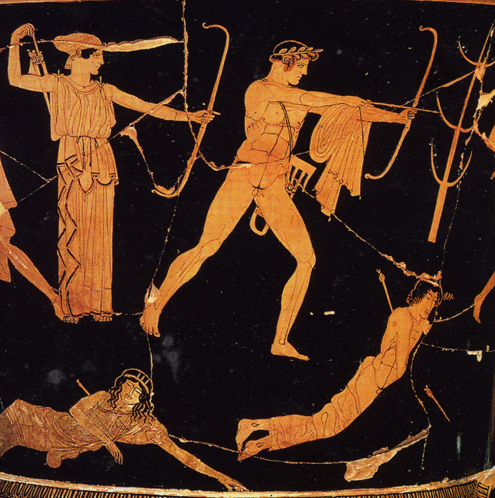
This page is dedicated to attributions of images and multimedia that are not in the Image Gallery, where attributions are associated with images already. We have done our best to make these accurate and to give full credit. The bulk of the material here comes from Creative Commons or out-of-copyright sources. A few are used by permission. If you have any correction to make on attributions or disagree about the copyright status of an item, please contact us.

































































2) The Anatomical Lesson of Professor Pauw. Engraving by Andries Stock (1616). Image from: http://www.artic.edu/aic/collections/artwork/51094
3) Illustration by Andreas Vesalius: De Humani Corporis Fabrica Libri Septem. Basel: Johannes Oporinus, 1555. Image from: https://library.missouri.edu/exhibits/anatomy/images/vesalius1555_plate.jpg
4) Illustration by Juan Valverde de Amusco in 'Historia de la composición del cuerpo humano' (p. 64). Published in Rome, 1560. Image from https://en.wikipedia.org/wiki/Juan_Valverde_de_Amusco#/media/File:Valverde_p64.jpg.
6) Frontispiece of John Browne's 'Myographia Nova: Or, A Graphical Description of All of the Muscles in the Humane Body, As They Arise in Dissection'....London: Thomas Milbourn, 1698. image: https://library.missouri.edu/exhibits/anatomy/images/browne_plate.jpg. From Anatomical Illustration: Art informing Science: an online exhibit at University of Missouri Library.
7).The Four Temperaments
Woodcut illustration by Leonhard Thurneysser in 'Quinta Essentia' (1574). The illustration represents an alchemical understanding of the human body, relating the four humours to the four elements and twelve signs of the zodiac. Image from Wikimedia Commons.
10) Speigel: Plate "IIII" from De Formato Foetu, Adriaan van den Spiegel. Adriani Spigelli Brvxellensis Equvistis... De Formato Foetu: Liber Singularis Aeneis Figvris Exornatus.... Frankfort: Matthæus Merianus, 1631. From Anatomical Illustration: Art informing Science: an online exhibit at University of Missouri Library
11) Frontispiece illustration of operating theatre in Bartolomeo Eustachius' 'Tabulae Anatomicae'. Published in Amsterdam, 1722. Image from Anatomical Illustration: Art informing Science: an online exhibit at University of Missouri Library.
12) Illustration of kidneys from Bartolomeo Eustachius' 'Tabulae Anatomicae'. Published in Amsterdam, 1722. Image from https://library.missouri.edu/exhibits/anatomy/images/eustachius_plate.jpg
13) Illustration of dissection scene from 'Fasiculus Medicinae, an eclectic collection of six medieval treatises on medicine. This collection, which originally existed only in two handwritten manuscripts, was first printed in 1491 in Latin and came out in numerous editions over the next 25 years. Johannes de Ketham, the German physician to whom the text is often attributed, was neither the author nor even the original compiler, but merely an owner of one of the manuscripts. A copy of this text is currently in the U.S. National Library of Medicine.
14) The Great Doctors of Antiquity (Frontispiece of 'Methodus Medendi, 1530) Frontispiece of Thomas Linacre's Latin version (Paris, S. de Colines, 1530) of the Galenic treatise 'Method of Healing". Image from The Wellcome Library, London.
15) Woodcut illustration of 'wound man' from an early German translation of' 'Fasciculus Medicinae', a collection of medical texts on various topic including the treatments of wounds and injuries, herbal remedies, bloodletting, and urology. Image from: http://circulatingnow.nlm.nih.gov/2014/07/22/the-wound-man-in-two-recent-acquisitions/
16) Points for Bloodletting Illustration by the surgeon Hans von Gersdorff from Feldtbůch der Wundartzney (Field Book for Wound Medicine, 1517) illustrating the major points for administering bloodletting. Image from: https://commons.wikimedia.org/wiki/File:Gersdorff_Feldbuch_s16.jpg














1) Ancient Discoveries Series 1 Episode 2: Galen, Doctor to the Gladiators: Wild Dream Films: Youtube: https://youtu.be/nnhDMNlq298
2) The Secrets of Ancient Medicine: Documentary & Life Discovery HD: Youtube: https://youtu.be/lQ3L2BMNVkk
Podcasts from Kings College London series "The History of Philosophy without any Gaps" curated by Peter Adamson:
1) Hippocratics: the Good Humour Men. narrated by Peter Adamson,